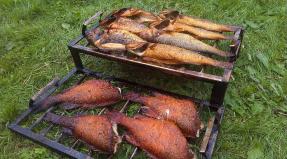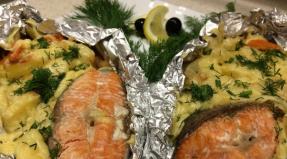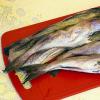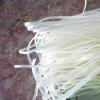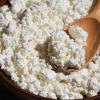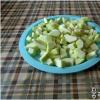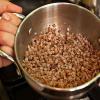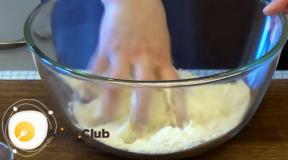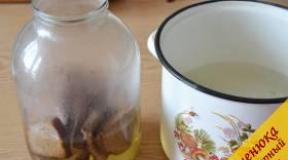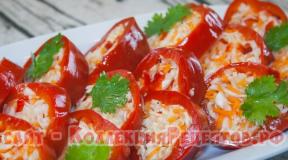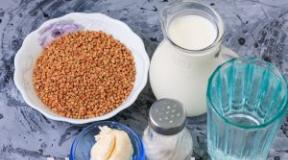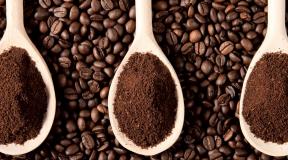Preservation of fish at home in jars. Recipe for preserving pink salmon at home
Preservation recipe for sprats from river fish
Kitchenware: three glass jars with a volume of 0.5 liters; three iron lids for jars; kitchen ceramic knife; pressure cooker; wooden cutting board; measuring cup and kitchen scale; capacious deep bowl; capping device; a warm blanket.
Ingredients
Step by step cooking
- We clean the fish in the amount of 900-1000 g from scales, then cut off the tail, head, fins and take out the insides. Rinse the fish thoroughly under a strong stream of cold water. Cut the carcasses into small pieces about 2.5-3 cm wide.
- We spread the chopped product in a deep bowl and add 18-20 g of salt there, mix thoroughly.

- At the bottom of each jar we put 8-9 peas of a mixture of peppers, 1 bay leaf, a pinch of nutmeg and 2 cloves.

- We tightly lay the prepared pieces of fish on top of the spices to the level of narrowing of the neck of the jar.

- Pour the fish with sunflower oil so that all the pieces are covered with liquid. We cover the jars with lids and put them in a pressure cooker.

- Pour cold clean water into the device to the level of the narrowing of the neck of the cans. We close the pressure cooker with a lid and send it to a strong fire. Bring water to a boil, then reduce heat to low. We leave canned food to cook for 2.5-3 hours. After three hours of canning, remove the pressure cooker from the stove and let the water cool completely.

- We take out the cans from the water and roll up the lids with a device designed for this. We send canned food to a dark place, wrap them in a warm towel and leave them in this form overnight. We clean the cooled preservation in the refrigerator or cellar for long-term storage.

You can follow the whole process of preserving sprats at home by watching the video below.
- When choosing fish, I advise you to pay special attention to perch, roach, minnows, ruffs. Canned fish from the listed types of fish will surprise and delight you with its aroma and unusually pleasant taste.
- If you are going to add chopped spices to canned food, mix them with fish pieces, and do not put them separately in a jar.
- Cloves and nutmeg are very fragrant spices that have a specific taste, so do not put too much of them. Moderately added spices will give canned fish a pleasant spicy taste.
- The recipe indicates the amount of salt to obtain lightly salted preservation. If you like salted fish, then increase the amount of this spice.
Recipe for preserving river fish in tomato sauce
Time for preparing: 1 day and 10 hours.
Calorie content (per 100 g): 92-99 kcal.
Number of cans: four liter jars.
Kitchenware: a large-diameter frying pan, preferably with a non-stick coating; wooden spatula with a thin edge; measuring cup and kitchen scale; several capacious bowls; four liter jars and four lids for them; wooden board for cutting; kitchen ceramic knife; large saucepan; cloth or kitchen towel; a warm blanket; canning machine.
Ingredients
Step by step cooking
Preparing the fish

Let's prepare canned food

Carefully remove the jars from the pan and roll them up. We put the canned food in a dark place and wrap them in a warm blanket. When the jars are completely cool, we send them to a place for conservation storage.
Video of the recipe for the conservation of river fish
You can watch the step-by-step canning of river fish in tomato sauce in the video below.
Recipe for canned river fish in a slow cooker
Time for preparing: 4:20-4:40.
Calorie content (per 100 g): 123-128 kcal.
Servings: from 3 to 7.
Kitchenware: kitchen ceramic knife; several deep containers of different sizes; multicooker of any brand; wooden cutting board; measuring cup and kitchen scale.
Ingredients
Step by step cooking
- Fish in the amount of 900-1000 g are cleaned, washed and gutted.

- In the bowl of the device we lay out 6-7 bay leaves and 11-13 peas of allspice. Peel the onion, rinse thoroughly and cut in half. We send the onion halves to the bowl with spices.

- Cut the fish into pieces 3-4 cm wide.

- We spread the chopped carcass into the bowl of the device and add 8-10 g of salt.

- Pour 65-70 ml of vegetable oil and 10-12 ml of vinegar there. Then add 230-300 ml of water. The liquid should completely cover the pieces of fish.

- Close the lid of the device and select the program "Extinguishing" or "Simmering". We cook the dish for about 4-4.5 hours.

- After the specified time, we leave the fish to simmer in the "Heating" mode for about 10-15 minutes.

Video of the recipe for the conservation of river fish
After reviewing the video below, you will learn how to cook canned river fish in a slow cooker according to the above recipe.
- Do you want to surprise and pamper your family with an unusually fragrant and amazingly tasty dish? Prepare a hodgepodge with sausage and pickles. It is believed that this dish comes in handy the next day after a stormy feast.
- It is no less tasty and very nutritious. This delicacy will appeal to all members of your family, even picky eaters. You can also slightly simplify the recipe and cook. This dish will be a wonderful decoration of the festive table.
- Have you ever tried? If not, start collecting the necessary ingredients right now. Amazing taste, delicious aroma and exquisite look of the dish will amaze any gourmet.
- Friends will appreciate your culinary skills if you cook something delicious for them.
- “Funchoza with chicken and vegetables” confidently replaces the usual pasta and egg noodles from Russian cuisine. If you want to know why, then cook this unusually tender and amazing-tasting dish.
I hope that after reading my recipes, you are intrigued and are already going to the supermarket for ingredients for preserving fish. Be sure to tell in the comments about your family's impressions regarding canned river fish according to the above recipes. If you are familiar with other canning recipes, share the information in the comments. I wish you only enthusiastic exclamations and praises! Eat for health!
Fish lovers! Here is the most popular selection of fish canning recipes. I hope you find the best recipe for yourself.
1. Fresh-frozen pink salmon - 2 kg, Tomatoes - 2 kg.
✓ Carrots-800 g.
✓ Bulb onion -500g.
✓ Salts -1.5 tbsp (30g),
✓ Sugar sand -200g.
✓ Vinegar 9% - 5 tbsp. l.
✓ vegetable oil - 400 ml.
✓ Bay leaf -3 pieces, black pepper to taste.
But, fish can be any. Pass the tomatoes through a meat grinder and simmer for 20 minutes. Cut the onion, fry in vegetable oil.
Grate carrots on a coarse grater and fry in oil. Prepare fish (remove heads, tails and entrails, bones).
Combine everything together and simmer for 1 hour. Add vinegar 5 minutes before the end of cooking.
Put the finished mass into sterilized jars, roll up, wrap until completely cool.
2. Sardines
Before cooking sardines, you need to gut all the insides of the fish, clean it from scales, cut off the head, tail and fins.
Salt the fish to your taste and leave to lie for 30-40 minutes at room temperature. Transfer the fish to a colander and dip in boiling sunflower oil and fry for 2 minutes.
In prepared jars for preservation, put 1 bay leaf, 3-5 peas of black allspice at the bottom.
Put the cooled fish in jars, pour in sunflower oil, in which there were sardines for 2 minutes. Cover the jars with a lid and heat over low heat for 45 minutes.
Then roll up the jars with the contents hot. Sterilize rolled jars for 50-60 minutes. Repeat the sterilization process 3 times every 24 hours.
3. Sprats at home
From small fish (perch, roach, minnows, ruffs, dace, etc.) at home, you can cook a dish that tastes like sprats.
To do this, the fish must be cleaned of scales, remove the insides, heads, fins and tails, rinse the carcasses. At the bottom of the pot (or pressure cooker) you need to put a layer of onion, cut into rings, salted carcasses on it.
Lay three or four layers in this way, but at the same time fill the pan no more than 2/3 of the volume. Add allspice, bay leaf, pour vegetable oil, vinegar and dry white wine or water.
For 1 kilogram of fish, 200 grams of onion, 100 grams of oil, 50-9 percent vinegar and 150 grams of dry wine or water, spices and salt to taste will be required.
Simmer over low heat under a tightly closed lid for three to five hours (in a pressure cooker 1-1.5 hours).
In cooked fish, the bones become so soft that they do not need to be separated from the fish meat when eaten.
4. Canned fish in oil
After removing the entrails, the fish (mullet, bonito, etc.) are thoroughly washed from blood, drained and cut into pieces depending on the size of the dishes intended for canning.
Then the fish is kept for half an hour in a saline solution (250 g of salt per 1 liter of water). It is washed from salt and fried on all sides in vegetable oil until browned.
Fried fish is placed in a glass jar. Between the pieces put grains of black and allspice, bay leaf and slices of lemon.
Then it is poured with vegetable oil, in which the fish was fried, so that there is a 2 cm oil layer on top of the fish. Store in a cool place.
5. Fish in tomato sauce, home canning.
Recipe for 4 standard jars with a capacity of 0.5 liters.
In asp, pike perch, carp, gobies, the belly is cut, in horse mackerel and mackerel, the heads are cut off, the insides, tails and fins are removed.
Peeled asp, carp and mackerel are cut into pieces, gobies and horse mackerel are preserved whole. The fish is washed when the water drains, sprinkled with salt at the rate of 1 tablespoon of salt per 1 kg of fish and after 30 minutes rolled in flour, fried in vegetable oil on all sides.
Cool for 30 minutes, put in jars and pour boiling tomato sauce 2 cm below the top of the neck of the jar.
To prepare the tomato filling, 300 g of onion are peeled, cut into slices and fried until golden brown in 150 g of vegetable oil.
2 kg of mashed tomatoes are poured into an enamel bowl, put on fire, add fried onions, 4 cloves, 4 bay leaves, 4 grains of bitter and allspice, 4-5 tablespoons of sugar and a tablespoon of salt, 4-5 tablespoons of 5% - vinegar, bring to a boil.
Banks are filled 2 cm below the top of the neck, put in a pan on a wire rack. The amount of water in the pan should be 3-4 cm below the top of the neck of the jar, and its temperature should be 70 degrees.
The pan is put on fire, covered with a lid, brought to a boil and the jars are heated for 50 minutes. After that, each is covered with a lid and sterilized for 6 hours.
After sterilization, the jars are cooled without being removed from the pan and without opening it.
The amount of fresh fish for 4 cans with a capacity of 0.5 l: asp - 2 kg, pike perch - 2.4, carp - 3.6, gobies - 3.2, horse mackerel - 2.2, mackerel - 2.4 kg.
To reduce the processing time, you can use the method of re-sterilization.
To do this, the filled jars are closed with lids, placed in a saucepan with water heated to 70 degrees, boiled for 50 minutes, the quality of the cans is checked and sterilized three times for 90 minutes with breaks of 24 hours.
After each sterilization, the jars are cooled in the same pan where the heat treatment was carried out, without draining the water and without opening the pan lid. The initial water temperature during the 2nd and 3rd sterilization is 20-30 degrees.
6. Recipe for preserving pink salmon at home
Salt like this: take a steak, in a plastic bag, pour salt and a little sugar there
For about 0.5 kg of fish, a tablespoon of salt and half a teaspoon of sugar.
Shake the bag and refrigerate.
Take out a couple of times a day to shake and clean again.
After 2-3 days salted pink salmon is ready.
7. Minnows stewed in marinade
Put oil, finely chopped onion, parsley root and greens into a saucepan or pot, pass through.
Add bay leaf, salt, pepper, chopped tomatoes, not gutted minnows, simmer for at least 4~5 hours and let stand.
Serve with mashed potatoes sprinkled with dill. Such minnows are obtained like sprats in tomato sauce with soft bones. Store below 15°.
600 g minnows, 50 ml oil, 2 onions, 3 tomatoes, 1 bay leaf, 6 peppercorns
They do the same with other fish, especially small ones. If simmering in a pressure cooker, then 30 minutes is enough.
8. Recipe for canning small fish
How to preserve fish at home. Get smaller fish, such as perches, brushes, crucian carp, etc. clean them.
Then cook vegetable frying from grated carrots and finely chopped onions.
Add sugar, salt, vegetable oil and your choice (tomato paste, tomato juice or tomato sauce) to it, then mix all the ingredients well.
After that, put raw carrots on the bottom of the pressure cooker, then fish, add salt, pepper, onion and tomato. Then repeat again carrots, fish, onions and so on until almost the end of the pressure cooker.
Pour all this with vinegar, add 100 grams of preferably white wine, bay leaf, black pepper and 12 cups of water for piquancy.
Stew all this for about one hour, but this is the time for small fish, if you have a large fish or cut into large slices, it must be stewed for about two hours over low heat in a pressure cooker.
After full readiness, spread the prepared composition into small jars
9. Canning fish at home
If you have a lot of fish, it is not necessary to salt or dry it. You can stock up on excellent canned fish. Any kind of fish is suitable for canning - river, lake, sea.
Only fresh fish is suitable for the preparation of canned fish. It must be processed only in a clean room.
The utensils and materials that are used must be kept in perfect cleanliness, strictly follow the recommended recipe and processing conditions.
The time of sterilization of canned fish (8-10 hours) can be reduced by repeated or multiple sterilization.
Now it seems that the question of the need to prepare canned fish at home is not urgent, because the variety of fish products and canned food on the shelves of stores may well satisfy any consumer.
And yet, there are times when canned fish is necessary, and we often have complaints about canned food made in an industrial way: the fish in them turns out to be far from natural, and for some reason they don’t ask us about the additives that are there, we are faced with a fact already when opening a jar of canned food.
That's why some people prefer homemade canned food. This is quite real, and there are many options for preparing canned fish, as well as heat treatment methods.
What is the best fish to preserve?
Any. More specifically, from river fish, especially tasty canned food is obtained from roach, ruff, crucian carp, perch, carp, bream ...
From sea fish, saury, pink salmon, mackerel, herring are preferable.
Any fish, even the most prickly and bony, softens its bones during cooking and does not pose any danger.
What utensils are best used for cooking canned fish?
You can use a pressure cooker (the fastest cooking method), a slow cooker. And if this is not the case, then a conventional oven is enough.
What canning options are available at home?
With the addition of oil or tomato and vegetables.
Recipe for canned fish with tomato (for quick use)
Medium-sized carrots - 4 pcs.
Onion - 5 heads
Ripe tomato - 3 pcs.
Ready ketchup - 1 pack
Salt, pepper, bay leaf, vegetable oil - to taste
Clean the fish, gut and rinse well. Place sliced onions and carrots into the pressure cooker. Put fish on top, pour vegetable oil and ketchup, sprinkle with salt, add peppercorns and bay leaf. Slice the tomatoes and place on top. You can add any other seasoning that you prefer.
Bring the ingredients in a pressure cooker to a boil, make a slow fire and cook for 1 hour. Open the pressure cooker lid only after it has completely cooled down. Such canned food can be stored in the refrigerator for several days.
Recipe for canned fish (for long-term storage)
Salt the prepared fish and sprinkle with any seasonings to your taste. Put in an enamel bowl and leave to marinate for 1.5-2 hours.
Prepare jars (preferably the same size): wash and dry.
Put the marinated fish tightly in jars and cover with foil. This is done so that the fish and juice do not stick to the lids. Put the jars on a baking sheet on the bottom row of the oven at a temperature of 130-150 °. As soon as you notice that the juice starts to boil, you should reduce the temperature to 100 ° and leave the jars for about 5 hours. After that, boil the vegetable oil and fill the jars with it to the top.
Roll up jars with sterilized lids.
Canned food can also be prepared with the addition of tomato paste or ketchup.
Canned fish recipe
Onions - 2-3 heads
Tomato paste - 2 tbsp. spoons
Parsley root and celery
Black peppercorns, bay leaf, salt - to taste
Vegetable oil for frying and adding to jars
Clean, gut and rinse the fish well. If it is very small, keep the heads and tails; if the fish is medium or large, it must be cut into portioned pieces, and the broth should be boiled from the heads and tails in a small amount of water.
Canned food can be prepared in its own juice with the addition of vegetable oil. Can be cooked with stir-fry and vegetables.
Salt the fish, pepper and leave for 2 hours, sprinkled with apple cider vinegar or lemon juice.
Then roll it in flour and fry in vegetable oil until light brown.
Separately, fry the carrots and roots, cut into cubes, and onion half rings.
1) Put the fish with the ingredients in a pressure cooker
2) Put the fish with the ingredients in jars
Pour 2/3 of the fish broth (pressure cooker or jars), add peppercorns, bay leaf. But adding broth is not necessary, you can cook fish in your own juice.
Jars can be sterilized in the oven, covered with foil, for about 4 hours (at the minimum setting).
You can sterilize them in a large pot of water, which after boiling must be reduced to a minimum fire. Sterilization time is about 5 hours.
In a pressure cooker, the fish cooks for about 2 hours. After that, it must be transferred to pre-prepared jars (sterilized and dry) and rolled up with sterile lids.
Hello to all readers of my blog. Today I dedicate an article to fishing enthusiasts. As I said earlier, my husband loves to fish, and it's not just summer fishing. He fishes all year round.
So we had to figure out what to do with a lot of river fish. Of course, part of the fish goes to prepare various dishes, another part - to cook ram. And it is eaten with beer with great pleasure! But there is another way to save the fish. How do we do it?
We prepare canned fish at home. To be honest, my beloved husband is involved in the entire procurement process. And I'm just happy about it. Well, I don't like cleaning fish! What can you do?
True, the cooking process is not short. We will cook it in the oven. But it's really worth it! And I would also call this dish not just economical, but super economical. Don't believe! Then look at the required ingredients.
Required Ingredients
- any river
- salt to taste
- peppercorns
- seasoning for fish
- Bay leaf
I'm not listing the ingredients here, as the salt and seasoning will be to your taste. And the amount of pepper and bay leaf I will indicate below.
How to do
To prepare this dish at home, do the following:
- We clean, gut and wash the fish.
- Then cut the fish into pieces.
- Add salt and seasonings to taste.
- We leave the fish for an hour and a half so that it is saturated with all the flavors.
- During this time, I wash the banks. Usually we use half a liter.
- At the bottom of each jar we put two bay leaves and three peppercorns.
- After that, fill the jars with fish and close them with foil on top.
- Then we put the jars on the wire rack in the oven, and under them we put a baking sheet with water. We do this so that the liquid that boils in the jars does not stain the oven and does not burn.
- We set the grid to the second division from the bottom. The temperature in the oven is 180 degrees.
- After boiling, the temperature decreases to 100 - 120 degrees.
- In general, the fish is stewed for 8 hours. After this treatment, the bones in canned fish become very soft.
- About half an hour before the end of cooking, heat the vegetable oil and carefully pour it into jars.
- We cover the jars with metal lids and keep in the oven for another half an hour. In the end, of course, we roll up the cans.
Ours in oil at home is ready!
Of course, it is much more convenient to cook this dish in an autoclave. Here here you can buy it.
If your husband - the breadwinner, earner, fisherman - sometimes brings a solid fish trifle, and the cat is no longer able to eat all this wealth, you have to cook this trifle somehow. Just what to do with her? If you fry it - you won't see it in the pan, if you cook the fish soup - it's all bones ... But don't throw away the catch, really! From fish trifles, and not only from it, you can cook a chic appetizer that just flies off the table. These are homemade canned fish, which for some reason are always compared with store-bought ones. Even the names of the recipes always sound something like this: “Sprats are almost like store bought”, “Sprat in a tomato, like from a store”, etc. Why "like from a store"? It's much tastier! Canned fish is indispensable for feeding a student child or a beloved husband working on shifts with homemade delicacies. And the guests who suddenly appeared will not remain hungry.
And now - the recipes! All homemade canned fish are prepared in oil, in tomato, in own juice or in marinade. We will give here the most interesting recipes, and you choose.
Sprats №1
Ingredients:
1 kg small fish
200 g onion
100 g vegetable oil,
150 g dry wine or water
50 ml 9% vinegar,
salt, spices - to taste.
Cooking:
Small fish - perches, roach, minnows, ruffs, dace, etc. - remove the scales, remove the insides, cut off the heads, fins, tails and rinse the carcasses. At the bottom of the pan, put a layer of onion, cut into rings, then a row of fish carcasses, add salt. Then again a layer of onions, fish and thus fill the pan no more than 2/3 of the volume. Add allspice peas, bay leaf, vegetable oil, vinegar and wine (or water). Put on the stove and simmer over low heat under a tightly closed lid for 3-5 hours. If you have a pressure cooker, then the process is significantly reduced - 1-1.5 hours is enough. In the finished fish, the bones become so soft that they do not need to be separated from the pulp. Spread the finished sprats in sterilized jars and roll up.
 Sprats №2
Sprats №2
Ingredients:
1.2 kg sprat or saika,
200 g vegetable oil,
1 tbsp salt (no top)
1 stack strong tea brew
peppercorns.
Cooking:
Put the prepared fish in a stainless steel pan, sprinkle with salt, pour tea leaves, add vegetable oil and pepper. Simmer on low heat for 2.5-3 hours under the lid. Then remove the lid and simmer for another 25-30 minutes to evaporate excess liquid. Arrange the fish in half-liter sterilized jars, put in hot water up to the shoulders and sterilize for 10-15 minutes. Roll up.
Canned river fish in oil №1
Ingredients:
1-1.5 kg of river fish,
3-4 black peppercorns
100 g vegetable oil,
800 ml of water
onion, salt - to taste.
Cooking:
Clean and gut the fish, cut the large ones into pieces, the small things can be left whole carcasses. Salt. Place the finely chopped onion on the rack of the pressure cooker. Put peppercorns, bay leaf, lay pieces of fish on top and sprinkle with onions. Pour in vegetable oil and water, close the pressure cooker and put on high heat. As soon as steam comes out of the valve, reduce the heat to a minimum. From now on, cook the fish for 1.5 hours. Place the finished fish in sterilized half-liter jars, cover with lids and put to sterilize in boiling water for 5-8 minutes. Roll up.
 Canned river fish in oil №2
Canned river fish in oil №2
Ingredients:
1 kg of fish
700 g carrots
700 g onion,
vegetable oil,
salt, pepper pot - to taste.
Cooking:
Prepare river fish in the same way as in the previous recipe. Salt, put in an enamel container and soak for 1 hour. Meanwhile, grate the carrots and cut the onion into rings. Remove the fish from the brine and mix with carrots, onions and peppers. Pour 3 tbsp into each half-liter jar. vegetable oil, lay the fish, but not tightly, otherwise liquid will pour out of the jars when boiling. Cover the jars with old tin lids without rubber bands and place in a cold oven. Turn on the fire, heat up to 200 ° C and simmer from this moment for 4-5 hours. After that, roll up the finished canned food with lids, turn the jars over, wrap and cool.
Pike in oil
1 medium pike,
2-3 bay leaves,
3-4 peas of allspice,
vegetable oil,
salt, spices - to taste.
Cooking:
Gut the pike, cut off all excess, rinse and cut into large pieces. Salt to taste, add spices and leave for an hour and a half. In the meantime, wash the jars, scald them, put bay leaves and pepper on the bottom and fill quite tightly with fish to the shoulders. Cover each jar with foil and place in an oven preheated to 150°C. Place a baking sheet at the very bottom with a little water. As soon as the liquid in the jars begins to boil, reduce the temperature to 100-110 ° C and leave the jars in the oven for 5 hours. Then heat vegetable oil in a saucepan until boiling. Remove the jars from the oven, remove the foil and pour the boiling oil into the jars until it covers all the fish. Cover the jars with prepared lids, put back in the oven for 30 minutes. Roll up, wrap up, cool down.
 Carp, canned with oil
Carp, canned with oil
Ingredient
s:
1 fresh carp
1 tbsp vegetable oil,
1 garlic clove
1 onion
salt, spices (ground dill, coriander, black pepper) - to taste.
Cooking:
Clean the carp from scales and fins, remove the head and cut into small pieces. Salt, add spices. Put garlic on the bottom of a liter jar, pour in vegetable oil, put the fish tightly, put the onion on top, cut into rings, cover with lids and set to sterilize for 10 hours. As it evaporates, add boiling water (just boiling, otherwise the jars may burst!). After sterilization, roll up the jars. Store canned food in a cool place.
Canned fish in tomato
Ingredients:
1 kg of cleaned fish,
2 stack tomato juice
1 stack water,
2 tbsp Sahara,
2 tbsp 70% vinegar,
½ stack vegetable oil,
salt, pepper - to taste.
Cooking:
Combine all the ingredients, put in a saucepan and simmer over low heat for 7 hours. In a pressure cooker, this will be about 3 times faster (i.e., 2-2.5 hours will be enough). Arrange in sterilized jars and roll up.
 Fish in tomato sauce
Fish in tomato sauce
Ingredients:
1 kg of fish
2 kg of tomatoes,
1 tbsp salt,
150 g vegetable oil,
300 g onion
4 things. cloves,
4 peppercorns,
4 bay leaves,
1 tbsp salt,
5 tbsp Sahara,
3 tbsp 9% bite,
flour, vegetable oil - for frying.
Cooking:
Salt the prepared fish with 1 tbsp. salt and leave for half an hour. In the meantime, prepare the tomato sauce: boil the tomatoes and rub through a sieve, add spices, vegetable oil, salt, sugar and vinegar, put on fire again. Then roll the pieces of fish in flour and fry in vegetable oil. Arrange the fish in sterilized jars, pour boiling sauce over and sterilize in boiling water for 1 hour. Roll up the jars and sterilize for another 6 hours. Use glass lids instead of tin lids or secure them with a special lid holder to avoid tearing off the lids.
Sprat in tomato sauce
Ingredients:
3 kg freshly frozen sprat,
5 kg of tomatoes,
1 kg of bell pepper,
1 kg of onion
2 kg carrots
500 ml vegetable oil,
2 tbsp salt,
280 ml 9% vinegar,
sugar - to taste.
Cooking:
Pass the tomatoes through a meat grinder, grate the carrots on a coarse grater, cut the bell pepper into strips, and onion into half rings. Fry carrots, peppers and onions in vegetable oil until golden brown. Put the vegetables in a saucepan, add the tomato mass, mix and cook over low heat for 1 hour. Put the prepared sprat in a saucepan with tomato mass, mix and cook for another 1 hour. Then add salt, sugar, ground pepper, vinegar, mix, boil for 5 minutes and remove from heat. Arrange in sterilized jars, roll up, wrap and let cool.
 Sprat or capelin in tomato sauce with vegetables
Sprat or capelin in tomato sauce with vegetables
Ingredients:
3 kg of peeled sprat (capelin or herring),
3 kg of tomatoes,
1 kg carrots
1 kg of onion
6-7 tablespoons salt,
8-9 tablespoons Sahara,
100 g 9% vinegar,
bay leaf, peppercorns - to taste.
Cooking:
Pour the tomatoes chopped in a meat grinder or in a blender into a saucepan and put on a slow fire to boil. Grated on a coarse grater carrots and chopped onions separately fry in vegetable oil until golden brown. Don't forget to stir in the tomatoes, carrots and onions. Combine the tomato mass and vegetables, mix and place in a stainless steel or cast iron pan in layers: a layer of tomato-vegetable mixture, a layer of fish, and so on until the end. The last layer should be vegetables. Add spices and put on a slow fire, covered with a lid. Boil for 3 hours without stirring. 10 minutes before the end of cooking, add vinegar, pouring it evenly over the entire surface and piercing the mixture of fish and vegetables with a wooden stick so that the vinegar is evenly distributed throughout the mass. In the meantime, sterilize 10 half-liter jars, place the resulting canned food in them and roll them up. Turn over, wrap, let cool.
Fish stuff in tomato
Ingredients:
2 kg small fish
1 stack vegetable oil,
1 stack 6% vinegar,
1 stack tomato paste,
1 stack Sahara,
salt, allspice, bay leaf - to taste.
Cooking:
Put the prepared fish in a saucepan, pour in a mixture of oil, vinegar and tomato paste, add salt, sugar and spices. Cover with a lid and place in the oven preheated to 140-150°C for 3.5-4 hours. After boiling, reduce the temperature to 100-120°C. Arrange the finished canned food in sterilized jars and roll up.
 Fish in a fragrant marinade
Fish in a fragrant marinade
Ingredients:
4-5 kg of fish,
5 liters of water
3 tbsp Sahara,
1.5 tbsp salt,
3 g allspice,
2 g cloves
3 g coriander,
100 g apple cider vinegar (you can use 6% vinegar),
Bay leaf.
Cooking:
Prepare the marinade: add the spices tied in a gauze bag to the water, boil and let cool. Put the prepared fish in the marinade and leave for 3-4 hours. Then put the marinated fish in sterilized jars, add the bay leaf and pour over the marinade again. Close the jars with plastic lids and refrigerate.
Fish mince in marinade
Ingredients for a half liter jar:
350 g fish
70 g vegetable oil,
30 g 6% vinegar,
1 bay leaf,
3 black peppercorns,
3 peas of allspice,
8 g salt.
Cooking:
Clean the fish, rinse thoroughly until the turbidity and blood disappear. At the bottom of scalded jars, put bay leaves, peppercorns, salted fish, pour vegetable oil and vinegar. Banks roll up and put on sterilization in salt water at a temperature of 105 ° C for 2 hours.
 This is such deliciousness. True, some experts do not recommend preparing canned fish that are supposed to be stored for a long time at home, arguing that such canned food should be sterilized in autoclaves. And even sterilization in a pressure cooker, when a temperature above 100 ° C is reached with a hermetically closed lid under pressure, cannot be compared with the factory one. Sterilization of canned food for long-term storage should be carried out with the lid rolled up. If you put the rolled jars in the pressure cooker, close the lid tightly and start heating, then pressure will begin to rise inside the pot and inside the jars, but as soon as the sterilization is over and you release steam from under the pressure cooker lid, the rolled lids will fall off the jars. There is only one way out: to wait for cooling and a gradual decrease in pressure in the pan and jars, but this can take several hours, and canned food may darken and deteriorate in quality. True, you can look for and buy glass lids with wide sealing rubber bands and special clips that firmly hold the lid. Such lids were very common 30 years ago, when tin lids for rolling were still rare.
This is such deliciousness. True, some experts do not recommend preparing canned fish that are supposed to be stored for a long time at home, arguing that such canned food should be sterilized in autoclaves. And even sterilization in a pressure cooker, when a temperature above 100 ° C is reached with a hermetically closed lid under pressure, cannot be compared with the factory one. Sterilization of canned food for long-term storage should be carried out with the lid rolled up. If you put the rolled jars in the pressure cooker, close the lid tightly and start heating, then pressure will begin to rise inside the pot and inside the jars, but as soon as the sterilization is over and you release steam from under the pressure cooker lid, the rolled lids will fall off the jars. There is only one way out: to wait for cooling and a gradual decrease in pressure in the pan and jars, but this can take several hours, and canned food may darken and deteriorate in quality. True, you can look for and buy glass lids with wide sealing rubber bands and special clips that firmly hold the lid. Such lids were very common 30 years ago, when tin lids for rolling were still rare.
Such a powerful sterilization is necessary to destroy all possible bacteria. The fact is that in canned fish, meat and so-called natural mushrooms (those that do not use vinegar or another preservative) bacteria, spores and viruses that do not need oxygen to live can develop. They are called anaerobic. Anaerobic microbes include, in particular, botulism bacteria. Developing in an airless space, these bacteria release potent toxins. Even a small part of botulinum toxin, once in the human intestine, can lead to sad consequences.
Here are some horror stories. Therefore, be sure to sterilize canned fish or boil them for a long time, and also try to consume canned fish within 2-3 months and do not keep them warm. Even rolled cans are best placed in the refrigerator or in a cold basement.
Enjoy your meal!
Larisa Shuftaykina

